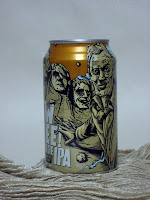My Beer Club brothers are determined to beat out of me every remaining trace of the anti-can prejudice I hold. Two canned beers made it into the lineup this week: Brew Free or Die IPA and Hell or High Watermelon Wheat Beer, both from San Francisco's 21st Amendment Brewery.
My rational side (which I like to consider dominant) understands that aluminum cans block the spoiling effects of UV light better than glass, and they also allow the beer to cool down faster in my fridge. But that side struggles against a lifelong association between cans and cheap beers like PBR, Red White & Blue (also a Pabst product, I find), Milwaukee's Best, and a rogue's gallery of other unsavory swill.
Now is the time to separate container from contents and get comfortable with aluminum cans. The craft beer movement has clearly embraced this compact, durable packaging, with high profile independents like Sierra Nevada, New Belgium (Fat Tire), and Spoetzl (Shiner Bock) on board, and dozens of others following suit in the past year -- some, like 21st Amendment, foregoing bottles altogether and distributing exclusively in cans.
In addition to carrying the aforementioned benefits, cans are cheaper for the breweries to buy and to transport, which means they can concentrate more of their investment into the beer itself. That should be a win-win for producers and consumers.
Brew Free or Die IPA
The can's panoramic label art depicts Abe Lincoln bursting forth from the stifling confines of Mount Rushmore, while Washington and Jefferson appear shocked and Roosevelt grins with hearty approval.
Pours pale gold and clear, producing two inches of persistent, large-bubbled foam. The aroma is quite subdued. What's there is hoppy, in the pine part of the spectrum. There is something ever so slightly funky -- maybe a touch of the dreaded dimethyl sulphoxide?
The taste is mainly of resinous hops, with a slight biscuit malt undertone. There is a light to medium weight to the body, and a slightly oily mouthfeel with medium carbonation. Again -- and I'm tasting very carefully because I'm trying to be strenuously objective about this canned beer -- I pick up a very faint note of something off. It is slightly onion-y, which would support the theory of DMS contamination.
Overall, even setting aside the off note I detected, I don't find much to distinguish this beer from the crowded pack of West Coast IPAs.
Hell or High Watermelon Wheat Beer
The label art depicts the Statue of Liberty setting down her torch and hanging her diadem from one of the towers of the Golden Gate Bridge, upon which she sits, dangling her feet into the presumably cool and refreshing waters of the San Francisco Bay.
In appearance, the beer is a pale straw color, and hazy with yeast. On top sits a half inch of bright white foam that roils like a bathroom cleaning product.
The smell is very sour. That's a note that would not be out of place in, say, a sour ale or a Belgian tripel, but remember we're supposed to be dealing with a wheat beer here. My first impression was of vinegar, but with diligence I corrected this to raw tofu.
I was not sure what to expect of the watermelon part. Mercifully, it is not an intense watermelon Now and Later® flavor, but something a little more subtle. After the light watermelon intro there is a somewhat clumsy hand-off to the wheat beer platform. I found it difficult to judge the wheat beer aspect on normal terms because of the fruit flavor gimmick. The carbonation is mild, and there is some telltale yeasty aftertaste. I think there's an OK beer under here, but I can't be completely sure.
Still, I'm not convinced this brewing experiment was worth the try. If I were going for something light and summery, I might have chosen to float the watermelon essences over a pilsner instead of a weissbier. As it turns out, the sour note, wherever it is coming from, detracts considerably from any refreshing effect this beer might achieve. In its favor I will say that this one did not exhibit any DMS aftertaste.
Featured beers:
Brew Free or Die IPA
Hell or High Watermelon Wheat Beer
Dishonorable mentions
Pabst Blue Ribbon
Red White & Blue
Milwaukee's Best
Brew Free or Die can views: (click to enlarge)
Hell or High Watermelon can views:














































